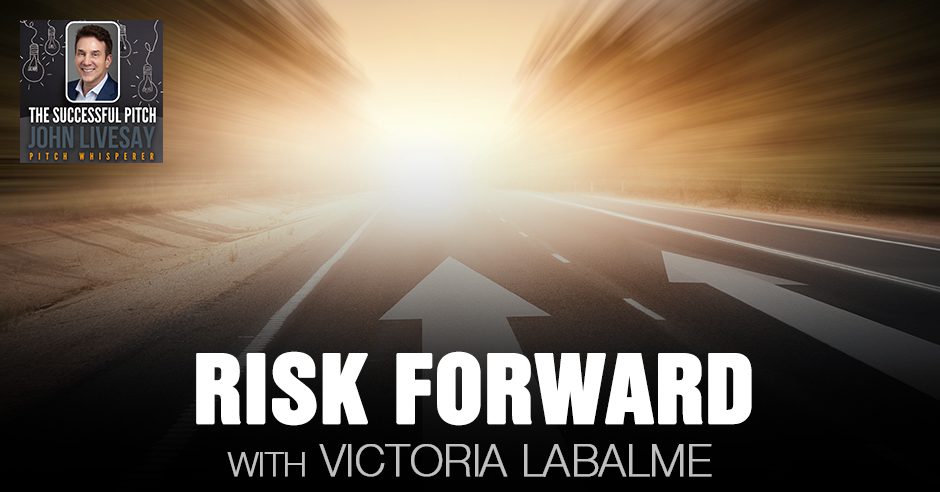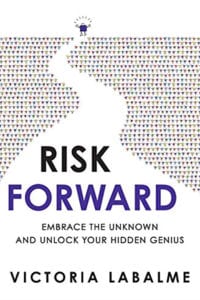Risk Forward With Victoria Labalme
Posted by John Livesay in podcast0 comments

What does it take for you to start embracing uncertainties? Taking a giant leap towards the unknown results in fear, but doing so can bring you to extraordinary things you may have never expected. What is the right attitude in the face of risks? John Livesay brings in actress Victoria Labalme to dissect the many nuggets of wisdom discussed in her book Risk Forward: Embrace the Unknown and Unlock Your Hidden Genius. She talks about how strict goal-setting may never lead to success, the five myths of achievement, and the right time to say no. Victoria also explains how art can be utilized to level up your businesses and change communities even in the smallest ways possible.
—
Listen to the podcast here
Risk Forward With Victoria Labalme
Our guest is Victoria Labalme, the Author of Risk Forward. She talks about trusting your hidden genius and how we have to learn how to embrace the fog of not knowing, and that sometimes goal setting can lead you astray. You’re going to enjoy the episode.
—
My guest is Victoria Labalme who is the Founder of Risk Forward and Rock The Room, which is a full suite of programs designed to help people express their hidden genius. Her strategies have been embraced by more than 700 organizations, entrepreneurs, senior executives and thousands of individuals around the world. As a performing artist and member of the Speaker Hall of Fame, she is known for her keynote performances. I can vouch for that. We shared a stage at the Coca-Cola CMO Summit. She is also known for her workshops, her private consulting, and online learning. Welcome, Victoria.
Thank you so much for having me, John.
It’s a joy to get somebody with so much talent, creativity and fun on the show and you have this wonderful book, Risk Forward: Embrace the Unknown and Unlock Your Hidden Genius. My first question before we get to your own story is did you start this book before the pandemic or did it happen to be a great timing?
I started it many years ago. I did a TEDx Talk on this topic back in 2016.
That’s what a thought leader does. They have their pulse on the zeitgeists of what people are going to need before they even know they need it, and that’s certainly you. Let’s go back to your own story of origin. I know you do such a fascinating job of this in your talks. You decide where you want to start the story whether it’s school days or the moment you decided, “I’m going to be an actress,” or wherever you want to start.
Growing up, I found that I was often making choices that took me down paths that are different from other people. I know many can relate. I made these choices that other saw were odd. I went to college out west and my family was back east. I decided to sign up for a 75-day expedition when my friends were signing up for graduate school. I was going left when everyone was going right. When people were getting married, I was staying single. When people were having babies, I was off dating different types of men. I always carved my own path. The thing that I found is that there was this judgment along the way where people would say, “What are you doing? What’s the plan? What’s the goal?” Whether it was your major or whether you’re going to get married or what your career was going to be, and I often didn’t know. Many people had a lot of different interests. We all often do, but we’re taught that’s wrong.
[bctt tweet=”Goal setting can lead you astray.” username=”John_Livesay”]
Pick one thing and major in it for the rest of your life.
It’s a counterproductive proposition for people who are multidisciplined, multitalented, and multi interested. I did lots of different things and oddly enough, me going into the not knowing, not getting married, not having a career path, not knowing how I’d put everything together led me to an extraordinary career. The book is about how we can go from this not knowing and follow what lights us up and find our way forward.
One of your early careers was being an actress. Give us a few highlights of Sex and the City back. I know you were on one of those episodes. I know people are always curious to hear some of those details.
I talk about that in the book. I tell a great story from being on Sex and the City. To answer your question, I started doing television commercials as an actor. I was interested in physical expression. I studied with a French mime, Marcel Marceau. I started studying all kinds of acting, performance, writing, directing choreography, character work in comedy. I got picked up by the manager who manages Robin Williams and Billy Crystal. I started doing all kinds of television appearances in a film with Robert De Niro and Harvey Keitel in documentary acting. My career started to take off and then something suddenly happened at the end of the 1990s. It was 2001. I witnessed 9/11 from my window and very much like the pandemic now, the whole world changed. I found myself again in a phase of not knowing and what’s next.
I started helping presenters, executives and entrepreneurs express themselves on stage and on-camera because I had this background. I had no idea how that was going to turn out. Someone had invited me to the National Speakers Association. They’d seen me in a comedy club and said, “You should come.” I thought, “I don’t want to be a speaker. That’s cheesy. That’s motivational. I want to be famous.” After 9/11 and like us in the pandemic, a lot of people started re-evaluating their choices. I thought, “How can I help? Here’s a place people are asking for my contribution. I’m being called to contribute.” I said yes. That yes was not knowing where it would lead. I had no plan. I had no goal but it took me into a whole new territory and I started in the world of speaking. I went from acting and performing to speaking in corporate, associations, and entrepreneurship. That career took off and that’s now how we met. I started coaching executives and entrepreneurs on storytelling, on presentation, on camera, on stage, in meetings and in life.
What I’ve found has happened since the pandemic is, I’ve been getting a lot of requests from sales teams saying, “In addition to teaching our team how to tell better stories to win business, can you help them be better on a Zoom call? None of them feel comfortable on the camera and they don’t have good lighting and there are some basic skills that they’ve never needed before?” What you are doing now is at a whole new level of, “This isn’t a nice thing to have a note. This is a must thing to have a note.”
I’m finding too that a lot of the people I’ve been helping are about how to bring out their own unique gifts. What you’re seeing with a lot of Zoom is everyone’s starting to look the same with their green screen background in their whizzbang technology. If you’re going to stand out and bring out what I call your hidden genius, what do you have that’s different from everyone else? How do you capitalize on that and trust that even if no one else is doing it? Part of what people get from reading the book Risk Forward and the whole methodology is to trust that, the permission to trust that what they’re doing is cool.
We also talk about how to navigate our way through the fog of the unknown, which is such a great visual. We’ve all been in fog. We’d have fog lights on our car and yet sometimes we have woken up a little foggy, pick our brain for whatever reason and no judgment. I’m fascinated to know when someone’s trying to embrace the unknown which is, “How long is this pandemic going to last? Should I change careers?” What is your advice in the book that can help people navigate that?
To circle back to what you called out, there are seven phases in the book and the first is to embrace the fog. I call it The Fog of Not Knowing. Most people see not knowing as something negative. In fact, in the pandemic, everyone says, “How do we get out of this? How do we have certainty again?” The assumption is that it’s bad to be not knowing. What the Risk Forward makes the case for is there’s huge potential in not knowing because in that gap or in that phase, one of the biggest mistakes we can make is to try to rush out as quickly as possible. To use the fog as an exact metaphor, it’s like jumping through the fog and you run into a wall. You go down a path that’s not right for you because you’re so panicked to get out.
The first phase is to embrace it and to say, “This might not be such a bad thing.” I’m not in any way saying that the pandemic is a good thing in the sense that people are losing their lives, their jobs, the economy has challenges, people are stressed in their marriages with their kids on Zoom. There’s a lot that’s very difficult, but there are also a lot of people saying they’re re-evaluating their lives and their choices. The fog is that gap between knowing and not knowing, that we want to not rush out of it too quickly.
You also talk about that sometimes taking action can be a mistake and I’m guessing that’s completely tied in to what you said about rushing into something because many people will tell everybody, “The worst thing you can do is think about something and don’t take any action.” That’s not always the case. If you run into a wall, there’s got to be a fine balance between no action and action too fast.
I have a client named Anne who like many people got into this treadmill of success. She was very successful and she felt like she had to keep going. She had to keep producing and people would always say, “You got to keep going. Why not?” It’s the more is better mentality. She came to me and she said, “I’m exhausted.” The thought of doing these next projects makes me drained. It’s not feeling good. What I want to do is risk forward and take a break. It’s not risking forward to always go for it.
[bctt tweet=”Embrace the fog of not knowing.” username=”John_Livesay”]
It’s not because you have an excuse like, “I’m pregnant. I’m sick.” This is like, “I’m taking a break because I want to.”
She lives in South Africa and she had the option to go into the bushes as they call it in South Africa. She said, “I want to not do this next series of projects. I want to pause on this. I want to honor myself and take a little break.” For her, that was the risk forward. That’s where the taking action. You’re that speed to market, go for it. We are in such a production type of culture where you’re evaluated and praised for your achievements, rather than acknowledge that sometimes it’s okay to take that break. She’s a private client. I was working with her in the Risk Forward private, VIP experience. She took the break and when she came back, she had clarity about where she wanted to go. Her launch did even better because she had taken that time off. She would have eroded her focus by doing all these other projects.
The big companies like Google give their team sabbaticals because they realize the value of it. You know this from your acting, the worst thing in the world to go to an actress, “What are you working on now?” If you’re somebody in the corporate world, “Have you gotten promoted lately?” Nobody wants to get stuck in that. That is a perfect segue into your tackling the five myths of achievement. Let’s pick the biggest myth and double-click on that a little bit.
The myth of goals would be the most or the myth of goal-setting. I have a phrase in the book which is, “Goal-setting can lead you astray.” I firmly believe that because there’s something called goal contagion. For example, and you probably know this because we’re in a similar field, when I run my Rock The Room programs so often people would come to me and they’d say, “I want to do a TEDx Talk or a Ted Talk. I want to have a New York Times Bestseller.” I thought, “You and 1,800 other people. Where did that come from? Did that come from within? Is that because everyone around you is doing it?” When I was in Hollywood, in my days of doing film and projects, this is now somewhat passed but all the directors used to wear leather jackets and have their hair in a ponytail. It’s like you see young women walking down the street in their flip flops, they have long hair, they’ve got white T-shirts, cutoff jeans, and all the girls look the same.
All the Millennial guys look the same with their beards.
There was a phase when all the guys would have their hair in that tuft on the top of their head with a little crisscross. I used to say like, “I want to put a golf ball in there and whack it like it’s a little tee.” The point is everyone starts to look the same. Whether it’s the cul-de-sac, the community, or the culture, what I’m encouraging in the book is to step back and make sure that what you want is what you want because otherwise, that goal will lead you astray. I’ve seen this so much in the entrepreneur, the speaker market, the corporate market, and the artists market where people have some target that is coming from without. They get it and they’re miserable, or they don’t get it and they’re miserable.

Embracing Uncertainties: One of the biggest mistakes is to try to rush out as quickly as possible.
I should tell you where the whole term comes from, but the risking forward is about following the inner current. Some of the most celebrated companies and creative endeavors didn’t begin with clarity and a goal. I worked with the leadership team at Starbucks, Microsoft, PayPal. I’ve worked with people on the opera stage. I worked with people with PBS Specials, huge talks around the world, Hollywood directors. I will tell you across the board, whether it’s corporate or Hollywood or anything in between, some of the most celebrated creative individuals and corporate individuals had no idea what they were doing. They were following that inner current.
It’s that gut. The classic story around that comes to mind is Steve Jobs creating the iPad. People were like, “Nobody wants that.” Do something even if no one else is doing it whether it’s a product launch or your own brand as opposed to going, “It looks like in order to be a speaker, you must have a New York Times Bestseller and give a TED or a TEDx Talk. Let me check those boxes off and then maybe I get to live my dream.” “Is that really your dream?” is what I hear you saying. If it is your dream then out of that, those things will happen more organically than outside references being, “I don’t want to write this book but I guess I have to.”
On that note, for years, people would say to me, “Where’s your book? You’ve got to have a book.” I don’t feel compelled from the inside out to write a book. I would only be doing it because I “should do it.” Finally, I got the idea of what I want to do. The idea came from within and it’s not your typical book. It breaks the mold because I have a background. I was doing all kinds of artistic disciplines, one of which was drawing and painting. The book is highly visual. It’s highly designed. Every page is different. Each chapter is unique unto itself. You can see this on Amazon. We have a little video that’s going up so you’ll be able to see that. This is full color. When people say, “I’m going to get the audio.” I go, “You’re going to miss out if you get the audio.” You’ve got to get this because the thing is you can read the book in any order. I didn’t want to make people feel like they could pick it up and read it in any section.
That is smart of you because creative people are not linear thinkers or linear learners. Rob Angel who created Pictionary is a client of mine. He took my online course and said, “I love that the modules could be done in any order.” It never even occurred to me because I tend to be linear that somebody might want to do that. I said, “Great.” You’re so smart to make your book like that for people like Rob Angel, who I’m sure will love this book.
Some people do like the linear and some people don’t. It sounds like what you’ve built in your course is both. It’s not that you have to do it out of order or you have to do it in the order, it’s you can choose. That’s exactly how my book is written. You can certainly read it from front to back or you can read it in one section.
It gives people the freedom to go, “I want to read that chapter again or that module again and reinforce one thing.” It does that. There are many good things that you have here. This concept that’s part of our uncomfortableness and anxiety around the unknown is a lot of people like structure, discipline and routine. Whether you’re training your dog or raising children, that’s all part of that world. We don’t realize how much we like it until things are uncertain, “When will I be back on the stage again?” You have a way to reframe that. Instead of thinking of it as the enemy, which we’ve all heard that wonderful quote, “What we resist persists.” If we’re going to resist uncertainty then you’re always at battle with yourself. How do you reframe that to being an asset?
[bctt tweet=”Some of the most celebrated companies and creative endeavors didn’t begin with clarity and a goal.” username=”John_Livesay”]
Things have always been uncertain. We’ve been under the illusion that they are not. I think 9/11 woke us up to that. When you have an emergency in your family whether that’s an accident that happens, an unexpected diagnosis, an unexpected death or a job loss, then we start realizing, “Things might not have been as secure as I thought.” The only thing that’s constant is change, as they say in the world of Buddhism. If we start by recognizing, things have always been uncertain. Part of why people are waking up so much now is they know that tomorrow is not guaranteed. They could have a job loss, we could have any kind of civil war. We could have any issue in our Coronavirus land.
People are waking up to the moment. That’s the first thing. That’s a good thing to wake up to the unpredictability and recognize that. The second thing is I’m all for clarity and goals. They’re great. What I’m arguing against is when we’re not yet clear. That window is fertile and it’s full of promise. In the book, I give people four questions that they can ask when they’re in that phase. They’re more than that but I call it the four questions. I’ll give you the first which is, “What interests me now?” That’s the key part.
Years ago, I took a workshop with a guy named Remy Charlip. He was this wonderful children’s book author, director and choreographer. He started the workshop not by having us introduce ourselves by what we have done because our past can hold us back. We feel we have to follow in line with what we’ve done. I’ve already produced ten films, I have to produce eleven. If I’m known for being this top salesperson, I have to continue to be a top salesperson. Instead, they’re going, “What interests me now?”
That pressure to not keep doing what’s been successful like Matthew McConaughey. You’re in sync with him completely because I watched him being interviewed. He said, “I’ve done rom-coms and made a lot of money. I don’t want to do that anymore.” He had to stop and put the pause button on. It was a while before he got another offer. He was willing to take the risk that might be the end of his career. Had he not, he’d never gotten those dramatic roles.
I have a line in the book which is, “Risking forward requires saying no.” There are times when it requires saying no.
I had a gentleman named Matthew Kimberley on and he said, “Your business should be a love story.” As a storyteller, I love that. You should be in love with what you’re doing, and you say we should approach our business as an art. I thought the two things together were a nice way for people to start going, “Maybe I could figure it out as a love story. How do I think of it as an art form?” What is your definition of art? Let’s start there.

Embracing Uncertainties: Today’s society has a production type of culture where you’re evaluated and praised for your achievements, rather than acknowledge that it’s okay to take that break.
It’s the expression of what’s inside of you. To that end, there’s a section in the book where I talk about something called the Prism Effect. I’ve been talking about this for many years. The idea is that each of us is this full range of colors. That’s your passions, your past, your personality. How do you harness that hidden genius of yours and bring it into your daily life even in the smallest of ways? For example, there’s a woman who is an administrative assistant. She happens to love the Oscars. She rolls out a red carpet by her desk every year in the Academy Award week. She is making a little piece of art in her own way. It’s small. I have another example in the book about the manager who loves poetry. She brings a line of poetry to every Monday morning meeting. This to me is turning your business into art even in the smallest of ways.
Even someone who’s making their coffee. Those people can be artists with those designs they make in the cappuccino.
Years ago in my office Downtown in Manhattan, the guy who was our janitor in the building used to lay out the garbage bags on a sidewalk in the most beautiful formations. He would enjoy that process. I find for myself that we all fall into the conveyor belt of our day, but if you step back and not get caught in the data, the duties, the deadlines, the details and say, “How do we make this moment a piece of art like the way I picked up the phone?”
What you’re encouraging all of us to do is broaden our term that unless I am a painter, I am not an artist. There are many forms of being artistic in communicating and expressing yourself. The most successful artists I’ve ever seen are making their art for themselves and not worrying about the masses. That goes full circle back to what you’re doing and saying.
That’s a scary thing. What I’m about to say goes counter-cultural to a lot of what people are teaching now so brace yourself. There are a lot of talks now about, “Who’s your avatar?” This crept up in the last number of years. An avatar is being, “Who’s your target market? Who’s your ideal client.” Because I came from the arts, we don’t think that way. We’re not thinking, “Who’s that ideal outcome?” It’s, “What is it I’d like to say? How do I say it in a way that’s going to land with people?” and then test it. This book, for example, a lot of people said, “Who’s the target meter?” I thought, “It’s resonating with people in their twenties who are out of college, or people who are in their 70s who were facing a creative project, or people who were in their 40s who were trying to find their new phase in life and a career transition. The book is for anyone who’s looking for that next step in work or in life.”
They’ll probably use it multiple times throughout their life if they start using it in their twenties. They’ll pick it up later in life and go, “I need to dust this off many years later. Now I need another hit of courage to take another risk.”
[bctt tweet=”Risking forward requires saying no.” username=”John_Livesay”]
You’re so intuitive because that is the vision for the book. I said, “I want this to be the kind of book.” It is the book that people will gift and give to others, and treasure for years to come, and keep for decades.
You’re certainly a treasure. Anyone who gets to hear you speak, that’s for sure. I want to ask you what interests you now? You’re always got something going on. In addition to your book launch, I’m sure there’s something else where you’re thinking, “What interests me now is?”
My full-on thing is the book and getting it into people’s hands because it’s beautiful. The response is quite moving for those who’ve read it early. It’s such a joy. We’re building this incredible community of people who want to risk forward in their work and in their life. What interests me now is hearing the stories of people who read this book and hear who it’s touching.
If people want to share their story of what they’ve done after reading your book, how should they do that? Is it by posting a review on Amazon? What’s the best way to do it?
There are three ways. Number one, they can post the review on Amazon. Number two, they can join us. We have not only a book but we’re creating a community inside. It’s called RiskForward.com/resources. Inside of that is not just the book. There’s more. For anyone who wants to also post their stories, they can come to me on my social media handles and post their stories there. In Amazon, the book and social.
What are your social media handles?

Embracing Uncertainties: When you’re in a period of transition, you are not wrong for not knowing because at the edge of it are the beginnings of the extraordinary.
@VictoriaLabalme but you can always find me through the #RiskForward.
It’s not just a book, it’s a movement. You read it here first. Victoria, any last thought or quote you want to leave us with?
When you’re in a period of transition, you are not wrong for not knowing because at the edge of not knowing is the beginning of the extraordinary.
It doesn’t get better than that. We’ll be sure to put the links to Risk Forward and Victoria’s website. Thank you so much for being on the show.
Thank you so much for having me.
Important Links
- Risk Forward
- Rock The Room
- Amazon – Risk Forward: Embrace the Unknown and Unlock Your Hidden Genius
- RiskForward.com/resources
- @VictoriaLabalme – Twitter
- Better Selling Through Storytelling Method Online Course
Wanna Host Your Own Podcast?
Click here to see how my friends at Podetize can help
Purchase John’s new book
John Livesay, The Pitch Whisperer
Share The Show
Did you enjoy the show? I’d love it if you subscribed today and left us a 5-star review!
- Click this link
- Click on the ‘Subscribe’ button below the artwork
- Go to the ‘Ratings and Reviews’ section
- Click on ‘Write a Review’
Love the show? Subscribe, rate, review, and share!
Join The Successful Pitch community today:
- JohnLivesay.com
- John Livesay Facebook
- John Livesay Twitter
- John Livesay LinkedIn
- John Livesay YouTube
Tags: goal contagion, goal-setting, hidden genius, risk forward, saying no, TEDx talk

